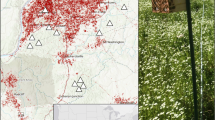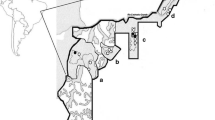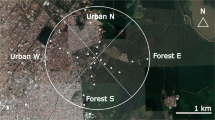Abstract
Andrena hattorfiana is a rare solitary bee which has declined during the last decades throughout western Europe. It is specialised to forage pollen from plants of the family Dipsacaceae. Knowledge of distribution, dispersal propensity, and local population sizes is essential for successful conservation of A. hattorfiana. The investigated local bee populations (n = 78) were dominated by small local populations and 60% were smaller than 10 female individuals and 80% were smaller than 50 female individuals. The area of the median occupied habitat patch was 1.25 hectare and harboured 7 female bees. Mark-release-recapture studies of female A. hattorfiana revealed a sedentary behaviour. Among pollen-foraging female bees the average registered distance moved was 46 m. The patch emigration rate was about 2%, with an observed maximum colonization distance of 900 m. Only 10% of the individuals crossed areas without the pollen plant within grassland patches, such as unpaved roads, stone walls and small tree-stands, even if these areas were less than 10 m wide. This study shows that solitary bees can occur in local populations of extremely small size and they have a sedentary behaviour. These are features that usually increase the risk of local population extinction.


Similar content being viewed by others

References
Abrams PA (2002) Will small population sizes warn us of impending extinctions? Am Nat 160:293–305
Bischoff I (2003) Population dynamics of the solitary digger bee Andrena vaga Panzer (Hymenoptera, Andrenidae) studied using mark-recapture and nest counts. Popul Ecol 45:197–204
Carlson A, Edenhamn P (2000) Extinction dynamics and the regional persistence of a tree frog metapopulation. Proc R Soc Biol Sci Ser B 267:1311–1313
Eickwort GC, Ginsberg HS (1980) Foraging and mating behaviour in Apoidea. Annu Rev Entomol 25:421–446
Falk S (1991) A review of the scarce and threatened bees, wasps and ants of Great Britain. Nature Conservancy Council, Peterborough
Frankham R, Lees K, Montgomery ME, England PR, Lowe EH, Briscoe DA (1999) Do population size bottlenecks reduce evolutionary potential? Anim Conserv 2:255–260
Franzén M (2007) Insect diversity in changing landscapes. Ecology Building, Department of animal ecology, Lund University, Lund
Franzén M, Nilsson SG (2007) What is the required minimum landscape size for dispersal studies? J Anim Ecol 76:1224–1230
Gärdenfors U (2005) The 2005 redlist of Swedish species. Swedish Species Information Centre, Uppsala
Gathmann A, Tscharntke T (2002) Foraging ranges of solitary bees. J Anim Ecol 71:757–764
Giovanetti M, Lasso E (2005) Body size, loading capacity and rate of reproduction in the communal bee Andrena agilissima (Hymenoptera; Andrenidae). Apidologie 36:439–447
Goulson D, Stout JC (2001) Homing ability of the bumblebee Bombus terrestris (Hymenoptera : Apidae). Apidologie 32:105–111
Greenleaf SS, Williams NM, Winfree R, Kremen C (2007) Bee foraging ranges and their relationship to body size. Oecologia 153:589–596
Hanski I (1994) A practical model of metapopulation dynamics. J Anim Ecol 63:151–162
Hanski I, Gaggiotti O (2004) Ecology, genetics and evolution of metapopulations. Elsevier Academic Press, Amsterdam
Hanski I, Singer MC (2001) Extinction-colonization dynamics and host-plant choice in butterfly metapopulations. Am Nat 158:341–353
Hanski I, Alho J, Moilanen A (2000) Estimating the parameters of survival and migration of individuals in metapopulations. Ecology 81:239–251
Hanski I, Kuussaari M, Nieminen M (1994) Metapopulation structure and migration in the butterfly Melitaea cinxia. Ecology 75:747–762
Hanski I, Moilanen A, Gyllenberg M (1996) Minimum viable metapopulation size. Am Nat 147:527–541
Hanski I, Pakkala T, Kuussaari M, Lei G (1995) Metapopulation persistence of an endangered butterfly in a fragmented landscape. Oikos 72:21–28
Harrison S (1991) Local extinction in a metapopulation context––An empirical evaluation. Biol J Linn Soc 42:73–88
Harrison S, Murphy DD, Ehrlich PR (1988) Distribution of the bay checkerspot butterfly, Euphydryas editha bayensis––evidence for a metapopulation model. Am Nat 132:360–382
Kapyla M (1978) Foraging distance of small solitary bee, Chelostoma maxillosum (Hym., Megachilidae). Annales Entomologici Fennici 44:63–64
Knuth P (1899) Handbuch der Blütenbiologie. Engelmann, Leipzig
Koenig WD, van Vuren D, Hooge PN (1996) Detectability, philopatry, and the distribution of dispersal distances in vertebrates. Trends Ecol Evol 11:514–517
Kremen C, Williams NM, Aizen MA, Gemmill-Herren B, LeBuhn G, Minckley R, Packer L, Potts SG, Roulston T, Steffan-Dewenter I, Vázquez DP, Winfree R, Adams L, Crone EE, Greenleaf SS, Keitt TH, Klein A, Regetz J, Ricketts TH (2007) Pollination and other ecosystem services produced by mobile organisms: a conceptual framework for the effects of land-use change. Ecol Lett 10:299–314
Kuussaari M, Nieminen M, Hanski I (1996) An experimental study of migration in the Glanville fritillary butterfly Melitaea cinxia. J Anim Ecol 65:791–801
Lamont BB, Klinkhamer PGL (1993) Population size and viability. Nature 362:211
Larsson M (2005) Higher pollinator effectiveness by specialist than generalist flower-visitors of unspecialized Knautia arvensis (Dipsacaceae). Oecologia 146:394–403
Larsson M, Franzén M (2007) Critical resource levels of pollen for the declining bee Andrena hattorfiana (Hymenoptera, Andrenidae). Biol Conserv 134:405–414
Larsson M, Franzén M Estimating the population size of specialized solitary bees. Ecol Ent (in press)
Levin DA, Kerster HW (1969) Dependence of bee-mediated pollen and gene dispersal upon plant density. Evolution 23:560–571
Linsley EG, MacSwain JW (1955) Observations on the nesting habitats and flower relationships of some species of Melandrena (Hymenoptera). Pan-Pac Entomol 31:178–185
MacArthur RH, Wilson EO (1967) The theory of island biogeography. Princeton University Press, Princeton, New Jersey, USA
Michener CD, Rettenmeyer CW (1956) The ethology of Andrena erythronii with comparative data on other species (Hymenoptera, Andrenidae). Univ Kans Sci Bull 16:645–684
Müller A, Krebs A, Amiet F (1997) Bienen. Naturbuch Verlag, München
Müller A, Diener S, Schnyder S, Stutz K, Sedivy C, Dorn S (2006) Quantitative pollen requirements of solitary bees: implications for bee conservation and the evolution of bee-flower relationships. Biol Conserv 130:604–615
Nilsson SG, Nilsson IN (2004) Biodiversity at Linnaeus´s birthplace in Stenbrohult, southern Sweden 4. The vascular plant flora and its changes. Sv Bot Tidskr 98:65–160
Oertli S, Müller A, Dorn S (2005) Ecological and seasonal patterns in the diversity of a species-rich bee assemblage (Hymenoptera: Apoidea: Apiformes). Eur J Entomol 102:53–63
Paradis E, Baillie SR, Sutherland WJ, Gregory RD (1998) Patterns of natal and breeding dispersal in birds. J Anim Ecol 67:518–536
Pekkarinen A (1998) Oligolectic bee species in Northern Europe (Hymenoptera, Apoidea). Entomologica Fennica 8:205–214
Pimm SL, Lee HJ, Diamond J (1988) On the risk of extinction. Am Nat 132:757–785
Saccheri I, Kuussaari M, Kankare M, Vikman P, Fortelius W, Hanski I (1998) Inbreeding and extinction in a butterfly metapopulation. Nature 392:491–494
Schoener TW, Spiller DA (1992) Is extinction rate related to temporal variability in population size? An empirical answer for orb spiders. Am Nat 139:1176–1207
Stephens DW, Krebs JR (1986) Foraging theory. Princeton University Press, Princeton, New Jersey, USA
Stith BM, Fitzpatrick JW, Woolfenden GE, Pranty B (1996) Classification and conservation of metapopulations: a case study of the Florida Scrub Jay. In: McCullough DR, Covelo CA (eds) Metapopulations and wildlife conservation. Island Press, Washington, pp 187–215
Thomas CD (2000) Dispersal and extinction in fragmented landscapes. Proc R Soc Biol Sci Ser B 267:139–145
Thomas CD, Harrison S (1992) Spatial dynamics of a patchily distributed butterfly species. J Anim Ecol 61:437–446
Thomas CD, Kunin WE (1999) The spatial structure of populations. J Anim Ecol 68:647–657
Thomas JA, Telfer MG, Roy DB, Preston CD, Greenwood JJD, Asher J, Fox R, Clarke RT, Lawton JH (2004) Comparative losses of British butterflies, birds, and plants and the global extinction crisis. Science 303:1879–1881
Tyler T, Olsson KA (1997) Förändringar i Skånes flora under perioden 1938–1996––statistisk analys av resultat från två inventeringar: rapport från Projekt Skånes flora. Sv Bot Tidskr 3:143–185
Walls SS, Kenward RE, Holloway GJ (2005) Weather to disperse? Evidence that climate conditions influence vertebrate dispersal. J Anim Ecol 74:190–197
Westrich P (1990) Die wildbienen Baden-Württembergs. Eugen Ulmer, Hohenheim
With KA (2004) Metapopulation dynamics: perspective from landscape ecology. In: Hanski I, Gaggiotti O (eds) Ecology, genetics, and evolution in metapopulations. Academic Press, London, pp 23–44
Zayed A, Roubik DW, Packer L (2004) Use of diploid male frequency data as an indicator of pollinator decline. Proc R Soc Biol Sci Ser B 271:9–12
Acknowledgements
Sandra Rihm, Charlotte Jonsson, Anneli Öhrström, Erik Cronvall and Sofia Larsson assisted in the field. Erik Öckinger, Anna Persson, Hanna Franzén and two anonymous referees gave valuable comments on an earlier version of the manuscript. This study was financed by the Nature Conservation Chain to L.A. Nilsson (initiated by Swedish Environmental Protection Agency) and by FORMAS to S.G. Nilsson.
Author information
Authors and Affiliations
Corresponding author
Rights and permissions
About this article
Cite this article
Franzén, M., Larsson, M. & Nilsson, S.G. Small local population sizes and high habitat patch fidelity in a specialised solitary bee. J Insect Conserv 13, 89–95 (2009). https://doi.org/10.1007/s10841-007-9123-4
Received:
Accepted:
Published:
Issue Date:
DOI: https://doi.org/10.1007/s10841-007-9123-4



